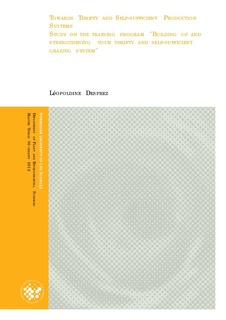| dc.contributor.author | Desprez, Leopoldine | |
| dc.date.accessioned | 2012-11-09T12:27:50Z | |
| dc.date.available | 2012-11-09T12:27:50Z | |
| dc.date.copyright | 2012 | |
| dc.date.issued | 2012-11-09 | |
| dc.identifier.uri | http://hdl.handle.net/11250/189490 | |
| dc.description.abstract | This study has been conducted within a farmers’ association in Western France (Loire-
Atlantique) promoting sustainable agriculture: the CIVAM DEFIS. The goal was to evaluate a
two years training program by identifying the profiles of the farmers who enroll in it and how
their systems have evolved. The targeted systems are dairy farms, cow/calf and sheep
operations, main livestock farms found in this geographical area.
The program itself is being carried out with the objective of helping farmers to implement
thrifty and self-sufficient grazing systems on their farms. The desired outcome of such
systems is to obtain viable and more sustainable farms by decreasing expenses. This is
done through the development of grazing proportion in the ration by a technique of rotational
grazing in paddocks.
Semi-directive interviews were conducted with 22 former and current trainees. As a result of
these discussions it was found that a majority of the farmers who enroll in the program came
to refine their technique and develop the grazing part but were already farming with grass
beforehand. This fact raises the question of why more intensive systems are not interested in
grazing systems. It seems that livestock grazing is perceived as obsolete and that farmers
are in some ways pressured into sticking to more “conventional” ways of farming.
As for the training program itself, it was found to be relatively efficient as 64% of the trainees
have succeeded in evolving their systems towards more thrifty and self-sufficient ones. The
remaining 36 % are farmers who had less grass-oriented systems at the enrollment time and
for whom two years of training seems to be too short of a time to implement all the necessary
changes both on their farms and in their way of thinking. Consequently suggestions of posttraining
coaching were made such as individual support or the creation of local groups. If
those suggestions were to be applied they could improve the program’s effectiveness into
promoting thrifty and self-sufficient grazing systems as they are highly profitable on many
levels. They are beneficial for farmers as individuals since they allow to improve both their
income and working conditions. The entire society can also gain from them as they help to
preserve farmers’ sovereignty and to produce healthy food at a fairly good level of
productivity per hectare while preserving the environment. | no_NO |
| dc.language.iso | eng | no_NO |
| dc.publisher | Norwegian University of Life Sciences, Ås | |
| dc.title | Towards thrifty and self-sufficient production systems : study on the training program "Building up and strengthening your thrifty and self-sufficient grazing system" | no_NO |
| dc.type | Master thesis | no_NO |
| dc.subject.nsi | VDP::Agriculture and fishery disciplines: 900::Agriculture disciplines: 910::Other agricultural disciplines: 919 | no_NO |
| dc.source.pagenumber | 86 | no_NO |
